Speak to a Tanzania expert today
and start planning your tailor-made holiday

Alistair
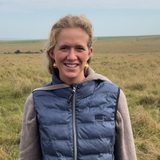

The Great Migration is the annual movement of the largest number of terrestrial mammals anywhere in the world. It’s often called the wildebeest migration, due to the fact that there are roughly 1.5 million of these animals that complete the journey across Tanzania’s and Kenya’s grass plains. However, they are far from alone, accompanied by over 200,000 zebras, as well as Grant's and Thomson's gazelles, elands and impalas.
The drama of this unrivalled wildlife spectacle is heightened by the attendant, opportunistic predators, including large prides of lions, hyenas, cheetahs and leopards. It is little wonder that this, approximately 1,000 km, roundtrip has been the feature of so many wildlife documentaries and is one of Africa’s biggest draws for safari enthusiasts, and a must to include in any Tanzania safari holiday.
This is a complex question and so one without a simple answer. In other parts of Africa, wildebeest are commonly non-migratory, so why risk the many perils of trekking such vast distances? About 250,000 animals will not complete the journey; crossing crocodile-infested rivers, picked off by predators and dying from starvation, thirst or pure exhaustion.
Fossil records suggest that the wildebeest have wandered this savannah ecosystem for more than a million years. The herds have evolved to move instinctively, driven by a variety of related factors; being drawn by the accumulation of distant storm clouds or the rumbling of thunder, localised weather patterns play an important part. The rains trigger fresh grasses to sprout and with it, the promise of better grazing. The famous river crossings between Kenya and Tanzania are often a draw for spectators, and it seems that for the wildebeest, the saying ‘the grass is always greener on the other side’ plays a key role in their motivation! It is thought that the distant rainfall and growth of new grass may produce chemical signals beyond our own sensory perception but that the wildebeest can follow. Although the exact science is still being debated, one thing is for sure, without fail the wildebeest up and go!
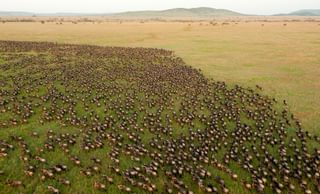
Just as the why is not straight forward, the movement of the herds doesn’t follow a set schedule and route. Therefore, there are no guarantees where they will be on a specific date; this is particularly true of the main mega herds or river crossings. However, with good planning and advice, you have a much better chance of being in the right place at the right time so you can be even more confident that a safari to these rich grasslands, home to one of the greatest concentrations of wildlife in Africa, will be exceptional.
Whilst you cannot be certain to find the huge migratory herds in a specific place at any given time, this annual trek does follow a typical pattern each year. Knowing this is the most important part of planning your migration safari; when to travel or where to stay if your travel dates are not flexible. This is most easily presented based on the changing months, seasons and weather patterns.
Where to stay will depend on the time of year you are visiting and your budget. There are a variety of styles of accommodation to choose from in the Serengeti and Masai Mara, which cater for a range of budgets. These include permanent lodges and tented camps, mobile camps that move to be close to the migration at different times of the year, and remote walking camps. Staying in a mobile tented camps doesn’t mean you will be roughing it, and depending on the price point you can expect a four-poster bed in a tent decorated with rugs etc so can be a very comfortable experience. I would personally recommend considering this style of camp, as the location can be exceptional. I would also highly recommend including a walking camp in your safari, as it offers a truly unique experience.
Although the migration is a roundtrip, without a set start and endpoint, it makes sense to commence with the beginning of the calendar year, which also brings with it new life, and is often referred to as the calving season.
During these months, the migratory herds are more dispersed across the southern Serengeti and the adjacent Ngorongoro Conservation Area. The herds do not rack up any huge mileage during this period and you won’t see the same concentrations as at other times of year. However, the large number of plain game grazing, the characteristic short grasslands, stretching to the horizon is impressive.
January often brings the start of calving season, with February being a peak month for births. Approximately half a million wildebeest calves arrive, with most being born over a period of just two to three weeks. This spectacle makes it an incredible time to visit.
Calving season is also a time of plenty for the high density of predators that reside in this area year-round. These predators make the most of having easy prey with the young calves whilst the mothers are distracted feeding. The Ndutu sector is renowned for predator sightings throughout most of the year, but now is its most popular season, with the big cats and hyenas highly active and a great chance of catching a cheetah hunt. The short grasses of this season make it easier to spot activity too.
For good reason, wildebeest calves are amongst the most precocious of animals, getting to their feet and walking within a matter of a few minutes. Whilst the majority of births are usually over by March, the herds remain, feeding on the nutrient rich grasses to build their strength for the arduous journey ahead. Tanzania’s heaviest rains tend to start during this month and the herds slowly creep up towards the Moru Kopjes, south of the park centre.
Where to stay
Ndutu Safari Lodge for a good value permanent lodge in this region. It’s set in a prime predator area and enjoys views over Lake Ndutu.
If you can stretch the budget, then I recommend Olakira Tented Camp. This camp is well worth considering for an authentic, but elegant bush experience, with game drives and walks accompanied by excellent guides.
Another step up and a little further north, in the Moru Kopje area, is the luxurious Serengeti Pioneer Camp, with breath-taking views.


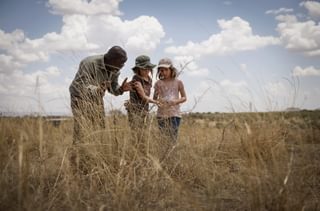
April and May bring the heaviest rains in Tanzania making it one of the least popular times to visit. The main herds generally remain in the southern Serengeti throughout April. It’s not certain exactly when each year the first wildebeest will raise their heads and decide it’s time to move on again. The young have had almost as little time to build their strength for their first migration as they had to be on their feet. Nonetheless, it’s often at some point in April that the ‘leaders’ start the march northwards. Slowly, but surely the others begin to follow on, so that by May most are on the go. Some head directly north, towards the central Serengeti and Seronera area, whilst the majority move more to the west, in the direction of the western corridor and Grumeti.
The peak rains require anyone visiting over this period to have a strong sense of adventure and some resilience. However, with the herds splintered into smaller groups, there’s a constant flow of activity. May, in particular, can be rewarding, due to the high predator numbers in the central and western sectors. You’ll experience your safari with few other visitors around and if you’re a bargain hunter you will find some great offers.
Where to stay
During April, Ndutu Safari Lodge is still a well-located permanent lodge option, especially for those on a slightly tighter budget. However, as mentioned, the rainy season brings some significant price drops and Lemala Ewanjan Tented Camp is brilliant at this time of year. It’s in a predator rich area and well-positioned to be able to explore the Serengeti in various directions, depending on where most of the action is.
A slight step up, but offering excellent value during these wet months and very well situated, is Dunia Camp. The camp has easy access to the Moru Kopjes and forest fringes of Seronera.
If you are travelling later in May and not limited by budget then Singita Faru Faru Lodge, overlooking the Grumeti River, is a superb and exclusive lodge. Located on a private concession, night drives and horse riding are also offered.
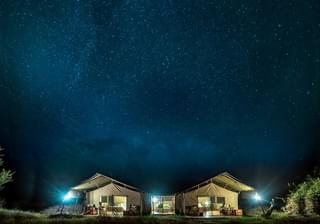
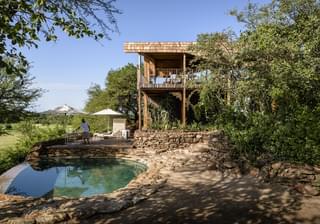
By June, most of the largest herds have reached the western corridor and the Grumeti River. The crossings of the Grumeti may not be as dramatic as those of the Mara River further north, but the steep river banks, flowing water and huge crocodiles that lie in wait are enough to make the wildebeest pause for thought. This results in an impressive concentration of animals until a seemingly critical mass is reached to make the crossing.
The males also contend for dominance and the right to mate with the females. The testosterone-induced noise and activity adds intensity to the atmosphere.
Through July the significant push north towards the winter grasses of the northern Serengeti and the Masai Mara continues. The second half of the month is generally when the main herds reach these plains and the incredible spectacle of the mass crossings of the Mara River begin.
A popular and rewarding time to visit, the best option over much of this period would be to base yourself in the western corridor or more centrally towards Lobo; possibly splitting your time between the two to optimise your game viewing chances. Later in July, the northern Serengeti, around Kogatende and Lamai, starts to come into its own.
Where to stay
Mbalageti Camp is a more affordable option situated in the western corridor, offering three different standards of accommodation. The camp has stunning views and reliable resident wildlife.
If you can afford it then Grumeti River Camp is exceptional. Located on a section of the Grumeti River, the camp offers luxury and sophistication, but without compromising the rustic bush feel. The guiding and wildlife viewing at this time of year is fantastic.
Later in this period, it’s worth looking at the camps further north, around Kogatende and Lamai, where you have much more choice. Ask us about these or see Aug/Oct for some suggestions.
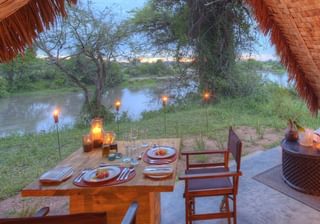
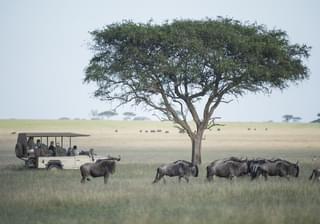
Those that survive the perilous Grumeti River continue northwards. As the dry season continues, the grasses of the Serengeti begin to turn yellow and the herds head further north towards the Masai Mara in search of wetter, greener pastures. But before they can reach the plains of the northern Serengeti and the Masai Mara in Kenya, where they usually remain throughout most of August to October, they must first cross the Mara River.
This is the prime time for river crossings, as the mega herds congregate and run the gauntlet of the Mara River, risking drowning, the jaws of awaiting crocodiles and predators looking to take advantage of their exhausted state the other side.
As mentioned earlier, there is not only one crossing north and then a return south. There are various crossing points along the river and the wildebeest will traverse back and forth over this period, with large herds crossing at different times. As the Masai Mara gets hotter and drier towards October, and the Serengeti rains begin, the herds begin to make their way back south, once again braving the treacherous river crossings in search of greener pastures.
In the northern Serengeti, the herds are more concentrated around Kogatende and the Lamai Wedge. Kogatende is the area closest to the main crossing points over the Mara River to Kenya and the Masai Mara on the other side. This is the ideal location to be at the centre of most of the action. The Lamai Wedge is a triangular area across the Mara River in the north-west of the Serengeti. Its more remote location, on the other side of the river, means there are fewer human visitors, but you are still in the thick of things in terms of the wildlife.
These are also extremely popular months with visitors to the Maasai Mara National Reserve in Kenya. The mega herds spend much of their time there, grazing the richer grasses, due to the localised rains that fall in this region.
If you are lucky enough to see a river crossing, it is a heart-pounding, emotional experience and one you will never forget!
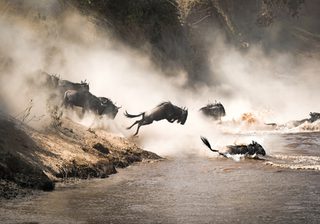
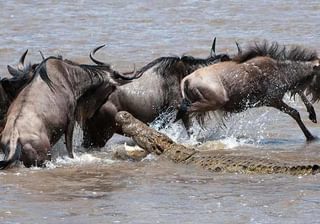
Where to stay
Kogatende Green Camp is brilliant to say in July through to October. It has a beautiful spot on a small tributary of the Mara River. Its remote location puts you away from the crowds, but within striking distance of the crossing points. The guides are exceptional and the camp is highly committed to minimising its environmental footprint, protecting this pristine area.
If your preference is for a permanent camp or to be situated in the Lamai Wedge, Lamai Serengeti Camp is a luxurious choice. Perched atop a kopje, the camp has magnificent views over the surrounding plains.
As mentioned, these are also great months to see the migration across the Mara River in Kenya. It tends to be slightly busier in the Masai Mara National Reserve than on the Tanzanian side at this time of year. A quieter option is to stay at a camp on one of the private conservancies adjacent to the reserve. The wildlife moves freely through these areas and they offer great game viewing year-round, with limits on the number of vehicles allowed at each sighting. The camps also offer game drives, often for a full day, to the crossing points within the Masai Mara. However, they are perhaps a little remote from the centre of the migration action and the main river crossing points.
If you are specifically looking to see a river crossing from Kenya, my recommendation is to stay within the Maasai Mara National Reserve. Governor’s is a great choice, with 3 different camps to choose between. Governor’s Camp enjoys a great location, offering an excellent value, classic Kenyan safari experience and is excellent for families. Little Governor’s Camp is slightly smaller and more intimate, set around a large waterhole, making it popular with couples or those on a Kenya honeymoon. Il Moran is a step up in cost, for those wanting extra luxury, once again in a spectacular setting.
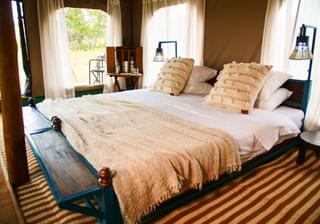

October is very dry and can be quite a harsh month for the animals. Whilst the herds may have already started to trickle south again, the mass movement, back to the southern Serengeti and Ngorongoro Conservation Area, usually takes place in November, which is also when the rains start for the short rainy reason.
Drawn by the little rains that stimulate the sprouting of fresh shoots on the short grass plains of the southern Serengeti, there is a lot of movement over this period, with herds becoming quite dispersed over a large area.
By mid to late December most wildebeest have reached the southern Serengeti and northern Ngorongoro Conservation area. Heavily pregnant, the females graze the rich grasses in preparation for a new year, new births and the cycle of the Great Migration to start again.
Where to stay
Despite the short rains, you may want to consider the northern Serengeti early in November, as you may catch the last of the crossings and there are some great deals to be had at the camps there at this time of year. For most of the period I recommend staying more centrally, around Seronera, or further south.
Naabi Hills Green Camp is a sound bet, certainly for the latter part of this period. The camp is well situated in the southern Serengeti to explore north towards Seronera or south into the Ngorongoro Conservation Area, depending on where the herds are.
Earlier on, Lemala Ewanjan Tented Camp is a good option to be centrally located. Dunia Camp is also an excellent choice with a remote and peaceful setting.
For the greatest luxury and a cooling dip in the pool, enjoying the fantastic views, Serengeti Pioneer Camp is the camp to go with.

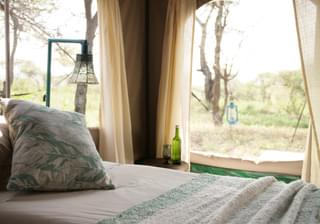
Game drives are undoubtedly going to be central to your migration safari, getting you close to the action for some great photographic opportunities. I would highly recommend at least a couple of nights’ stay at a walking safari camp in the Serengeti as part of your trip though. These mobile camps move with the herds throughout the year and offer all the creature comforts, as well as great food and superb guiding.
Setting out on foot across the grass plains opens up a whole new world. The tranquillity, unique perspective and thrill of the adventure combine to create an unforgettable experience. With some of the best professional guides in Tanzania, you will discover much more about the magic of this incredible place.
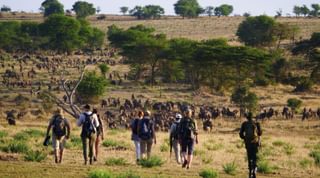
Active Safari
It depends on the time of year. The Wildebeest Migration spends most of its time in Tanzania and is there for around 9 months of the year from November - August (although exact dates vary each year). Whilst the migration is in Kenya for a shorter period of time, the Masai Mara is a smaller, more concentrated area and so it can be easier to see here - it is also a great period to watch the river crossings and so remains hugely popular from August to October.
Hopefully, the above has given you a better understanding of The Great Migration and is helpful in planning your trip. As you’ve probably realised, it’s not an exact science and it’s impossible to guarantee what the wildebeest will do and when. Our expert team has the latest insight into the movement of the herds and any special offers that the camps are running.
We would love to help you plan your perfect trip to experience the ‘Greatest Wildlife Spectacles on Earth’, so please call our friendly team of experts on 01768 603 715 and they'll be happy to help, or fill in our enquiry form.
and start planning your tailor-made holiday

